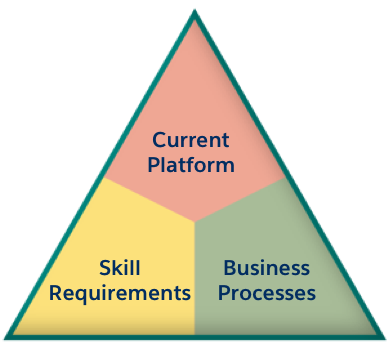Analyze Your Client's Needs
Learning Objectives
After completing this unit, you’ll be able to:
- List three benefits of performing a client analysis during the discovery phase.
- Explain how most implementation teams are created.
- Describe the alternative platform models.
- List what you must evaluate to determine how merchant capabilities fit with the Salesforce B2C Commerce platform.
Discover the Client
The discovery part of the client analysis gives you a chance to learn as much as possible about a merchant’s current implementation. What you document here is the before picture. At the end of a B2C Commerce site implementation, you get to see the after picture—a fully developed and tested solution that runs the merchant’s online retail business.
During the discovery process, it’s critical that you understand all facets of their business to ensure that the solution ends up being a perfect fit.
Client Analysis Benefits
There are many benefits of performing a client analysis during the discovery phase, from staffing to design to the ultimate solution.
- Strong Implementation Team—You gain a good understanding of who makes up your team, both directly and indirectly. Who are these people? Is the merchant’s management involved? Are there Salesforce employees involved? Do you have a prior business relationship with the merchant? Ohana is always super important!
- Excellent Team Skills—It’s important to identify your team members’ unique skills and abilities. This helps you plan each step of the process, based on who is capable of doing what. What skills are available for the short and long term?
- Focused Merchant Staffing—You need to learn how the merchant plans to staff their team to support the new solution. Will the people who currently support the site also support the new one?
- Awesome Design—By performing a client analysis, you can influence the design before it’s created. The more you know about the merchant’s current system, processes, and so on, the better you can make suggestions and influence decision makers.
- Appropriate Solution—The more details you uncover, the more likely that you’ll come up with an effective and usable solution that meets capabilities and expectations.
A well-researched design also results in faster speed to market for the solution, because many of the contingencies are covered. This makes for a happy merchant!
Evaluate Capabilities
Most implementation teams are created based on the current business situation. Existing employees or partners, well-versed with existing operations, are assigned to the new application’s implementation team.
Merchants have many different needs. They might want to expand channels to online sales, but don’t quite know how. Or they selected B2C Commerce, but are new to the business. They might already have an online retail application, but it’s on a platform that won’t scale. Maybe they aren’t happy with their current provider. Or they might want to move their online retail application out of their standard application’s space. For one reason or another, they decided on B2C Commerce because it seems like the best solution, both for immediate and long-term requirements.
In many cases, the merchant doesn’t have the in-house technical resources to implement their application on the B2C Commerce platform. It’s your job as the functional architect to evaluate their capabilities and determine how they best fit with the new platform, using this tri-level assessment.
- Current Platform—Collect information on the merchant technology and how they use it.
- Skill Requirements—Assess the current skills to identify gaps.
- Business Processes—Collect details on the merchant’s business processes.

Alternative Platform Models
Understanding how a merchant operates is key. You can start by categorizing them into a platform model: full-service, licensed, or a hybrid of the two.
Full-Service means that the merchant has technically light in-house teams because they rely on their platform provider for most of their business requirements. This can include product setup, content setup, campaign management, and other business processes. With this model, partners assume many of the technical roles to supplement the in-house team. Partners work with the platform provider to collect information, formulate a plan, and implement it.
Licensed means that the merchant works internally on licensed platform software that runs on their own hardware. In this scenario, merchants work directly with their internal technology partners to implement and enhance their existing site. These same partners, or other partners, step in to implement a new application.
Next steps
We learned about the benefits of performing a client analysis during the discovery phase and how most implementation teams are created. We described what you need to assess when comparing merchant capabilities with the B2C Commerce platform. We explored alternative platform models. Now it’s time to explore how data models work.